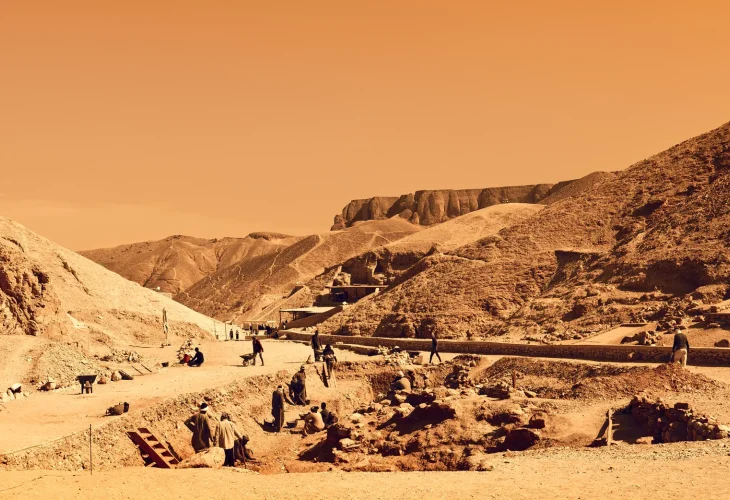The Temple of Onias: A Forgotten Chapter of Jewish History
Onias IV, once slated to be the High Priest in Jerusalem, was disqualified due to a deformity caused by his envious brother. In anger, Onias left for Egypt and established an alternative temple dedicated to Hashem.
 (Photo: shutterstock)
(Photo: shutterstock)Where was the Holy Temple? Every child knows the answer: In Jerusalem, on Mount Moriah.
But did you know that approximately 2,400 years ago, there was another Jewish temple, not in Jerusalem, nor in Israel, but in Egypt? This temple, erected by Jewish priests who had left Jerusalem, was named the "Temple of Onias." So, how did this come to be?
Onias IV belonged to the priestly family of Zadok. Zadok the priest was appointed by King David as the High Priest for the Holy Temple. His descendants served as High Priests until the exile of the last one by Nebuchadnezzar during the destruction of the First Temple. Joshua ben Jehozadak was the first High Priest of the Second Temple, appointed by Ezra the Scribe and mentioned by Zechariah the prophet.
Simon the Just, a renowned High Priest, is said to have met Alexander the Great when he conquered the Land of Israel from the Persians. Simon had a son named Onias IV, who was supposed to succeed him as High Priest in Jerusalem. However, envy got the better of his younger brother, Shimei, who caused a defect in Onias's ear, rendering him ineligible for priesthood. In outrage, Onias abandoned Jerusalem, fled to Egypt, and built a "substitute" temple for Hashem there.
How could this happen? Onias based his actions on a verse from the Book of Isaiah, as seen in a letter he wrote to Ptolemy King of Egypt and Queen Cleopatra: "I found within the fortress known as Pelusium an exceptionally beautiful place, filled with various trees and sacred animals. I am seeking permission to purify this neglected and ruined place and construct a temple for the Most High God, modeled after the Temple in Jerusalem, for your benefit and that of your wife and children, so that Jews living in Egypt can serve God peacefully. For Isaiah the prophet said, 'There shall be an altar for Hashem within the land of Egypt', and he foretold many similar things about this very place."
Indeed, the Book of Isaiah states, "In that day shall there be an altar to Hashem in the midst of the land of Egypt." However, Isaiah's prophecy was not intended to alter religious law or permit sacrifices outside the Land of Israel. It was merely a statement of a future circumstance, not a command. Nevertheless, Onias used this prophecy as a justification, transforming the location Pelusium into a grand temple. King Ptolemy supported the endeavor, wanting a secure Jewish settlement in the region to warn of any hostile movements. Among those assisting Onias was Dositheus, a notable Jew who co-managed the Temple of Onias. The city formerly known as "Heliopolis" came to be known as "City of Onias."
The Temple of Onias aimed to replicate Jerusalem's Holy Temple, but it lacked the iconic golden menorah, which Onias couldn't or didn't want to duplicate due to religious restrictions. Instead, he crafted a golden lamp that hung from the ceiling. The Talmud mentions individuals who made offerings to the "House of Onias," and it decrees that a priest who served there was ineligible to serve in the Jerusalem Temple, having violated Jewish law. Nonetheless, they were permitted to consume tithes and share them with fellow priests, as they retained their priestly status. Some opinions suggested that after the destruction of Jerusalem's Temple, sacrifices could be made at the Temple of Onias, though this view was refuted in the Talmud.
Today, the remnants of the Temple of Onias were discovered in a place known as "Tel el-Yehudiya," "The Mound of the Jews." Various inscriptions have been found there, including one mentioning "Abraham the builder," who constructed the temple. It was indeed structured like a fortress, in line with historical accounts, and once served a military purpose, with Jewish inhabitants quelling a rebellion against King Ptolemy.
During the Great Jewish Revolt against the Romans, after Titus destroyed the Second Temple in Jerusalem, he turned to destroy the Jewish temple in Egypt as well. The temple was left in ruins until archaeological digs about a century ago revealed its history, having stood for nearly 250 years before its demise.

